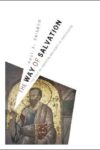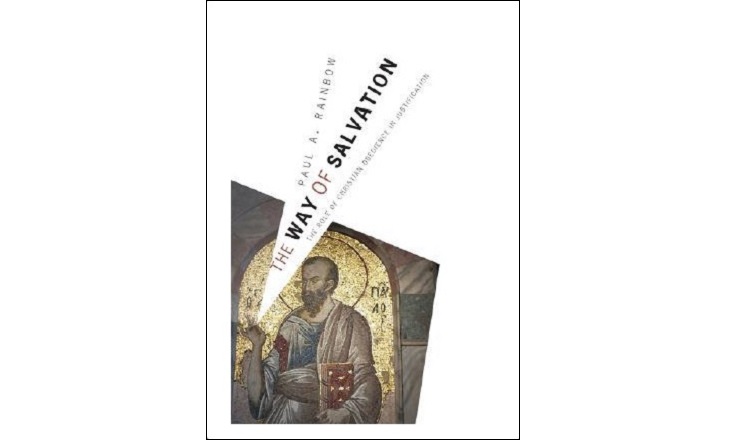 The main argument of Rainbows book is to contend against the reformers that grace inspired works after conversion are an intrinsic part of salvation and necessary in order to receive eternal life.
The main argument of Rainbows book is to contend against the reformers that grace inspired works after conversion are an intrinsic part of salvation and necessary in order to receive eternal life.
He agrees with the reformers that nothing a sinner can do prior to conversion can avail God to save them. However against the reformers, he argues after conversion and under the influence of the Spirit, a believer is enabled to perform grace inspired works and these are necessary for future salvation.
- Link: Amazon
- Length: 320
- Difficulty: Medium
- Topic: Theology, Topical
- Audience: Educated Christians, Mainstream Christians
- Published: 2005
Rainbow seems to be adopting a middle road between Protestant and Roman Catholic understandings of initial and final justification. This book is one of a few I’ve seen where the Roman Catholic sympathisers have seized upon the shakeup caused by the New Perspective on Paul and justification to again promote the instrumentality of works in final judgment and salvation.
This post is one of my book reviews.
The book unfortunately has strict copyright restrictions. Rainbow quotes others extensively through his book, but does not allow others to do the same from him without permission from the publisher. ‘Not happy Jan’. ? I’ll do my best to improvise.
Paraphrased Contents
- Contemporary discussion
- Reformers Luther and Calvin
- James (church leader) and Paul (Gentile missionary)
- The Old and New Testament Contracts
- Distinguishing deeds by sinners and believers
- Deeds of the law of Moses
- Righteousness
- Allergic to commands
- Substitution and Participation
- Spirit inspired growth
- Growing in holiness
- Tenses of righteousness
- Righteousness and holiness
- Final declaration of righteousness
- Righteousness in Paul
- Righteousness in James
- Bringing it together
- Ordo Salutis
- Relieving anxiety
- Other issues
Overview
Contemporary discussion. In this chapter Rainbow covers some of the contemporary discussion regarding justification. He discusses the Roman Catholic-Lutheran joint declaration, Stendahl, Sanders and Dunn from the New Perspective on Paul, reactions to them, and the biblical tension between justification by faith and judgment according to works.
Reformers Luther and Calvin. Rainbow gives a historical overview of the reformation. He considers the issues surrounding the church before Luther. Then the distinctive teaching of the reformers . He goes into the early problems generated by Luther’s teaching from the antinomians and the difficulties of teaching contradictory truths. He then considers Catholic responses to the reformation. Finally he asks a few questions about grace inspired works and justification which set up the next few chapters.
James (church leader) and Paul (Gentile missionary). This chapter has a look at James and Paul and considers their relationship to one another. Rainbow highlights that James was the appointed leader of the church. He says James wrote his epistle following discussions between him and Paul. He argues they were in agreement on the gospel. Looking at relevant passages in Acts and Galatians, Rainbow argues Paul deferred to James as his superior in the church.
The Old and New Testament Contracts. Rainbow contrasts Paul’s depiction of the covenants in scripture. Bifurcating law and grace, he seems to largely ignore Sanders understanding of covenant in Judaism. Rather he says the old covenant was conditional, that is both man and God made promises. He contrasts this with the new covenant which he argues is unconditional, only God promises to do things. The old covenant is law, strict justice. The new covenant is grace. He acknowledges the law of Moses is bound up with God’s covenant. Lastly he says God’s law extends beyond the law of Moses. Everyone is held accountable to God’s moral law.
Distinguishing deeds by sinners and believers. Rainbow surveys Paul’s use of works terminology making a distinction between the ‘works of law’ and ‘good works’. He seems to be unaware of Moo’s study on the same. Looking more at their source or origin of how they came about. In agreement with Origen and Ambrosiaster he argues Paul means works of human nature when he says ‘works of law’. I disagree. When Paul says ‘law’ He generally means the law of Moses. He defines good works as works of grace. Limited agreement, I don’t like to exclude human agency. He says the early reformers (e.g. Luther) botched this up, eliminating the validity of works before and after conversion. I agree.
Deeds of the law of Moses. In this brief chapter Rainbow considers Paul’s view of the law of Moses and what it was like living under it. He has a strong focus on humans in the flesh. He draws upon associations such as the law reveals sin, the law causes people in the flesh to sin more, the law has no ability to transform lives. He contrasts this with the believer’s life in the Spirit. He uses all this to define what Paul means by works of law. Arguing works of law are any works done in the flesh. I disagree.
Righteousness. Rainbow defines justification primarily as a forensic declaration of righteousness given to believing sinners that secures their acceptance with God. He looks at the usual suspect passages in Galatians, Romans, Genesis and Habakkuk to argue his opinion. He argues Christ’s righteousness is imputed to those who believe citing 1 Cor 1.30; 2 Cor 5.21; Rom 4.25; 5.18. He also highlights justification also applies to the goal of the believer’s life and what will happen at the end times. Something he notes omitted in standard reformed descriptions.
Allergic to commands. This chapter runs on the assumption that Paul’s message of justification by faith apart from works of law was understood to mean any kind of work (good, ceremonial, lawful, whatever) was unnecessary for people to gain or even maintain acceptance with God. This fosters antinomistic behaviour and license to sin. With this assumption in mind Rainbow surveys the apostles insistence that works are necessary in the believer’s life supposing they are reactions against Paul’s gospel.
Luther once remarked, ‘It is difficult and dangerous to teach that we are justified by faith without works and yet to require works at the same time’ (LW 27.62).
Clearly the new perspective doesn’t have this problem because of its restricted definition of works of law and the application of the expression revolving around fellowship with Gentile believers.
Substitution and Participation. Rainbows actual chapter heading suggests it is about faith. But I found the chapter comparing and contrasting Christ’s substitutionary atonement on behalf of the believer and the believer’s participation in Christ. In particular his death, burial and resurrection. He considers the latter with respect to the indicative/imperative relationship. He argues both are needed. No problem here.
Spirit inspired growth. This chapter considers the effect of grace in the believer’s life and notes this is inseparable from justification. The Spirit produced good fruit, the equivalent to God works.
Growing in holiness. Rainbow considers sanctification. Starting again with the indicative-imperative relatipnship he observes the Spirits resistance to the desires of the flesh. Then he takes a several page look at Romans 7.7-25 agreeing with many others Paul is not referring to Christians. Lastly he says believers will only be made perfect when Christ returns and they are glorified.
Tenses of righteousness. Rainbow argues rightly there are initial and final phases to salvation and justification in a believers lifetime. He grounds this in a brief survey of each of these passages: Gal 2.17; 5.4-5; 1 Thes 3.13; 2 Thes 1.5; 1 Cor 1.8; 4.2,4; 2 Cor 5.9-10; Rom 2.13; 2.26-29; 3.30; 5.9-10; 8.33-34; 14.18; Phil 3.9; 4.17; Col 1.22; 2 Tim 4.8, 16. He argues salvation is conditional on perseverance.
Righteousness and holiness. Rainbow briefly describes the relationship between justification and sanctification. He argues both are by grace and part of what it means to be united in Christ.
Final declaration of righteousness. This chapter is devoted to judgement day. Rainbow underscores the importance of faith. Then works through Gal 2.17; 5.4-5; 1 Cor 1.8-9; 1 Cor 3.15; 5.5; Rom 3.30; Phil 3.9; and Col 1.22-23 showing how they refer to faith in the final judgment. He then addresses the judgment according to works, working through another series of passages Gal 5.4-6; 1 Thes 3.12-13; 2 Thes 1.11-12; 1 Cor 4.2-5; 2 Cor 5.9-10; Rom 2.13,26-27; 8.33-34; 14.17-18; Phil 4.17; and 2 Tim 4.8,14,16. He then draws both strands together showing the inseparable nature of faith and good works in the final judgment. Lastly he shows how the reformers Luther and Calvin refused to acknowledge Gal 5.5-6 has anything to do with justification.
Righteousness in Paul. Rainbows preceding chapters are now drawn to the conclusion the reformers were wrong to deny grace fuelled obedience (synergism) is instrumental for final justification. He still wrongly defines works of law as ‘moral efforts of Adamic humanity’. But argues rightly Paul understood the works of law and good works are different things. Paul vehemently opposes works of law, he actively encourages good works. He argues the reformers put too much weight on what is necessary for initial justification, and used that to overrule what Paul says is needed for the final judgment.
Righteousness in James. James and Paul are now compared and contrasted with respect to faith, works and justification. Rom 3.28 and Jas 2.24 are directly compared. I felt he could have concentrated on Abraham a bit more. He rightly highlights Paul (at points) is on about initial justification and James, is looking at how believers are justified now and in the future judgment. Like before, he draws a lot of attention to the reformers. He highlights as I have done before their misunderstanding of what James said about justification.
Bringing it together. Ordo Salutis. In the next two chapters Rainbow starts to synthesise his arguments. He does this largely by reinstating what he has said before and comparing various steps of salvation with respect to justification, regeneration, sanctification and the final judgment.
Relieving anxiety. A common issue for the reformed reading is how one can have assurance. Rainbow addresses several issues associated with assurance and shows how believers can believe what he has argued and still maintain assurance of salvation.
Other issues. Rainbow gives a historical survey of a number of famous theologians through history showing the development and struggle of their thought. He looks at Luther, Melanchthon, Calvin, Bucer, Hooker, Baxter, Edwards and Wesley.
He concludes giving challenges to both Protestants and Catholics.
Recommendation
Rainbow quotes extensively from scripture and has a deep and broad knowledge of reformed and Catholic positions regarding the topic matter. He is a scholar. Authors, books and detailed footnotes are flying everywhere.
The book wasn’t to hard to understand. Readers don’t have to know Greek to read it. The book is really cheap, but there is no eBook version. ? I was annoyed I couldn’t quote from his book.
While I disagree with his take on the New Perspective, the overall purpose of Paul in Romans 1-4 and Gal 2 and in particular works of law. I have sympathy for his desire to assert the instrumentality of works in the final judgment and how this judgment is crucial for salvation. If you want to learn more about this, read the book.
Copyright © Joshua Washington and thescripturesays, 2016. All Rights Reserved.





